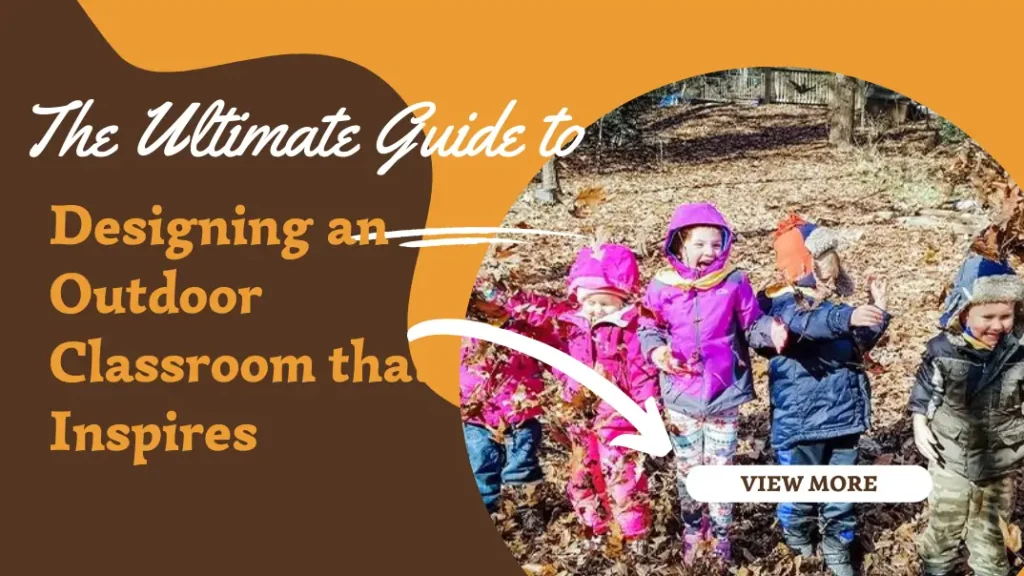Are you looking to create an outdoor classroom that stimulates young minds and promotes active learning? Imagine a space where children can run, explore, and discover the world around them. An outdoor classroom offers a unique learning environment that enhances physical activity, social skills, and creativity among children. Integrating the natural world into daily learning activities provides children endless opportunities to grow academically and personally.
Creating an inspiring outdoor classroom starts with understanding its many benefits and the elements that make it successful. The outdoor classroom is not just about taking lessons outside; it’s about creating an environment where nature is integral to learning. With the right approach, you can transform any outdoor space into a dynamic learning area for kids. This transformation goes beyond simple play; it involves structured activities that align with educational goals while fostering a connection with nature.
Curious about how to get started? Let’s explore the essentials of an outdoor classroom and some creative ideas to bring your vision to life. Many factors must be considered from choosing the perfect location to incorporating various educational tools. Each decision will contribute to creating a space that is not only educational but also engaging and enjoyable for children.
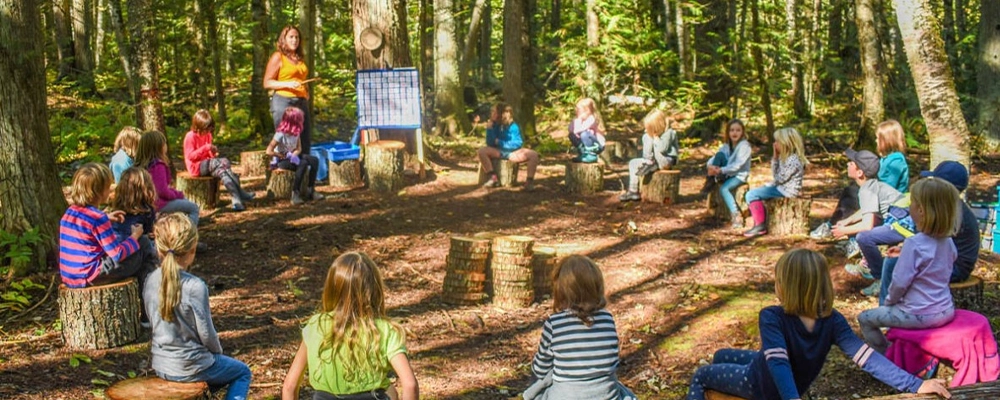
What is an Outdoor Classroom?
An outdoor classroom is a dedicated space outside traditional indoor settings where children engage in learning activities. This concept can take various forms, from simple garden plots to elaborate forest schools. The idea is to integrate the natural environment into the learning experience, providing children with opportunities to explore, discover, and learn through hands-on activities.
In an outdoor classroom, the natural surroundings serve as both the setting and the subject of education. Children might engage in activities like planting and tending to a garden, studying local wildlife, or observing weather patterns. These activities teach specific academic concepts and help children develop a deeper appreciation and understanding of the natural world.
Outdoor classrooms are designed to move beyond the constraints of four walls, offering a dynamic and stimulating environment where children can move freely and interact directly with nature. The learning activities in these settings are often multidisciplinary, combining elements of science, math, art, and physical education.
Additionally, outdoor classrooms can be tailored to fit various educational philosophies and curriculum requirements. For instance, a Montessori-inspired outdoor classroom might emphasize self-directed learning, with children choosing their activities from multiple prepared environments. Similarly, a Reggio Emilia approach might focus on child-led exploration and inquiry, using natural materials as the primary tools for learning.
Ultimately, the goal of an outdoor classroom is to create a holistic learning experience that fosters physical, emotional, social, and intellectual growth. By stepping outside the traditional classroom setting, children can engage in more active, hands-on learning that promotes curiosity, creativity, and a love for the natural world.
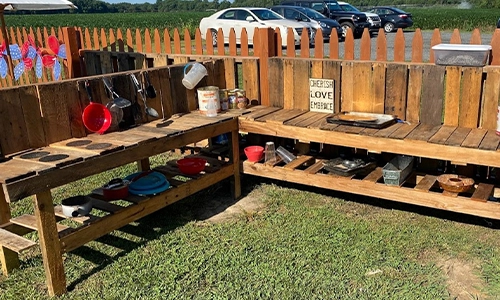
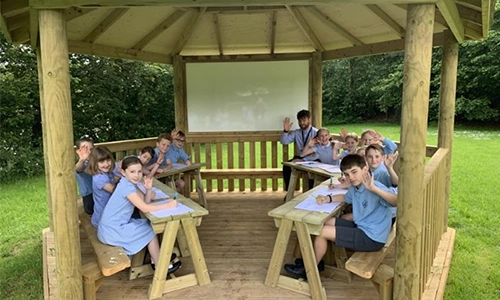
Benefits of Outdoor Learning
Outdoor learning offers many benefits that extend far beyond the traditional classroom experience. Here are some of the key advantages:
Increased Physical Activity Levels
One of the most significant benefits of outdoor learning is increased physical activity levels among children. Outdoor environments naturally encourage movement, whether it’s through running, climbing, or simply exploring. This helps children develop their gross motor skills and promotes overall physical health. Regular physical activity is crucial for maintaining a healthy weight, building strong bones and muscles, and supporting cardiovascular health.
Improved Gross and Fine Motor Skills
Outdoor learning activities often involve tasks that improve gross and fine motor skills. For instance, gardening can enhance fine motor skills through planting seeds and handling small tools, while activities like climbing and balancing develop gross motor skills. These skills are essential for children’s overall development and can support their ability to perform daily tasks with greater ease and coordination.
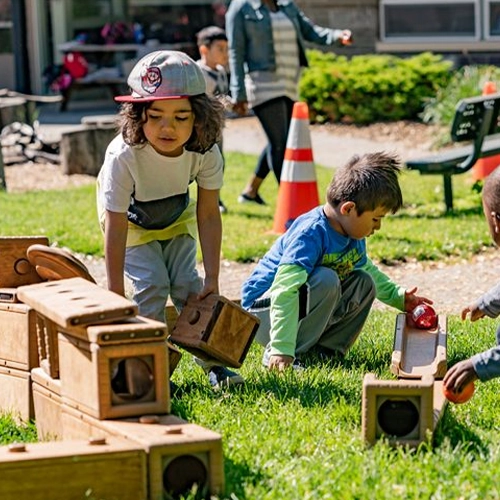
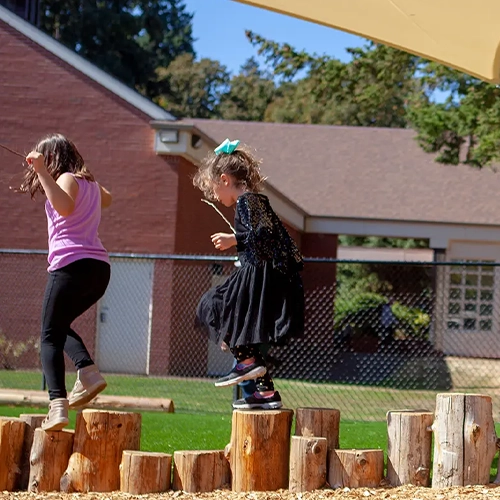
Better Social Skills and Cooperation
Engaging in outdoor learning activities allows children to interact with their peers in a less structured environment than a traditional classroom. This can lead to better social skills as children learn to communicate, share, and cooperate. Team-based activities, such as building a shelter or working on a garden project, teach children the importance of collaboration and teamwork.
Greater Creativity
The natural environment is a rich source of inspiration for creativity. Outdoor learning encourages children to use their imagination and think creatively. Whether they are building structures with natural materials, creating art from found objects, or coming up with solutions to outdoor challenges, the possibilities for creative expression are endless. This helps foster a love for innovative thinking that can benefit children in all areas of their lives.
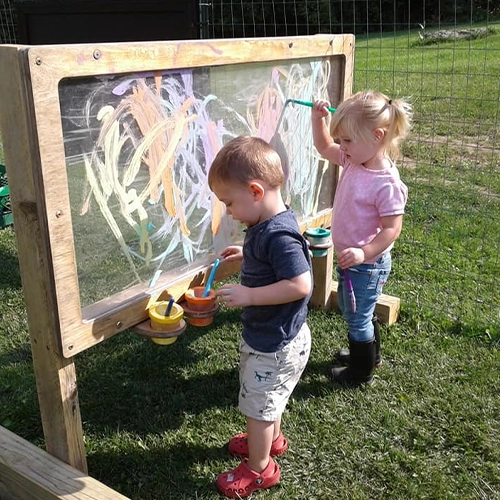
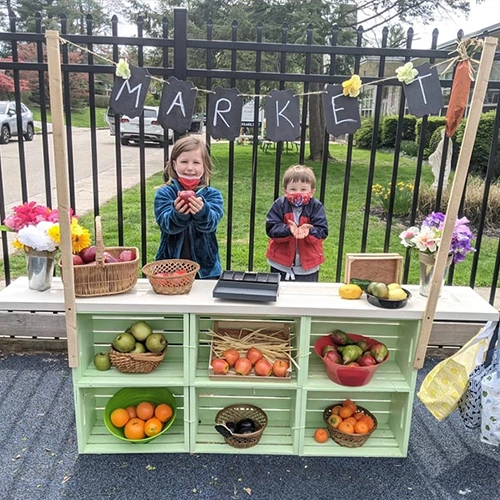
Enhanced Problem-Solving Skills
Outdoor learning often involves activities that require children to think critically and solve problems. For example, children might need to figure out how to navigate a nature trail, build a functional structure, or identify different plant species. These activities enhance their problem-solving skills and teach them to approach challenges logically and effectively.
Deeper Understanding of the Natural World
Spending time in an outdoor classroom allows children to better understand the natural world. They can observe the life cycles of plants and animals, learn about ecosystems, and understand the importance of environmental conservation. This hands-on learning approach makes complex scientific concepts more accessible and engaging for young learners.
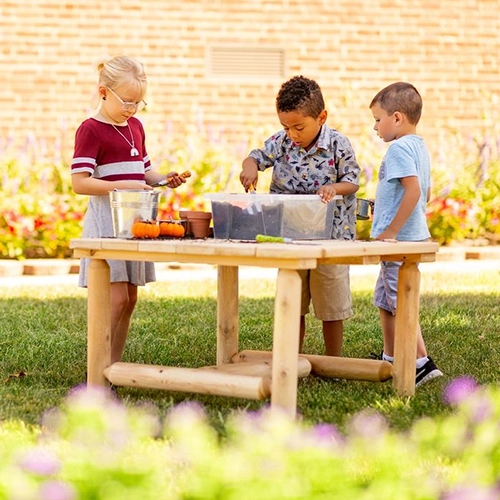
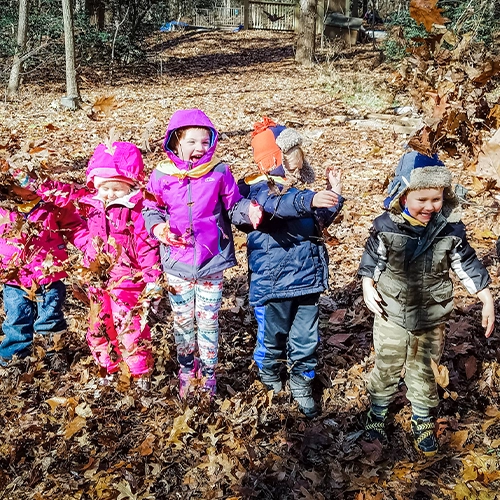
Improved Mental Well-Being
Being outdoors has been shown to have a positive impact on mental health. The natural environment can reduce stress, anxiety, and symptoms of ADHD. It provides a calming atmosphere that supports emotional well-being and helps children develop a positive attitude towards learning and life.
Increased Risk-Taking and Resilience
Outdoor learning encourages children to take calculated risks, such as climbing trees or navigating uneven terrain. These activities help children learn to assess and manage risks effectively. Additionally, encountering and overcoming challenges in the outdoor environment builds resilience and teaches children how to handle setbacks and failures constructively.
Engaged Learning
Finally, outdoor learning is highly engaging for children. The interactive and dynamic nature of outdoor activities captures their interest and motivates them to learn. This engagement leads to a deeper and more meaningful learning experience, where children actively participate in their education.
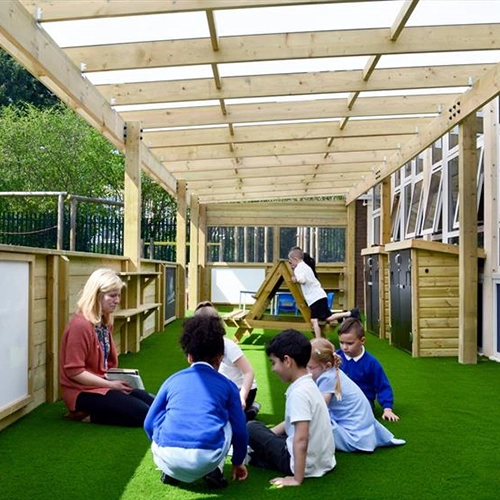
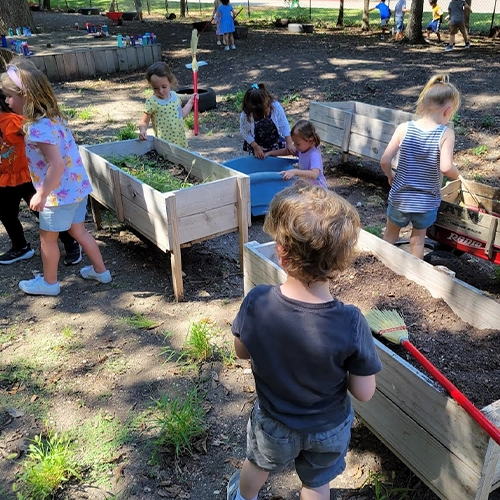
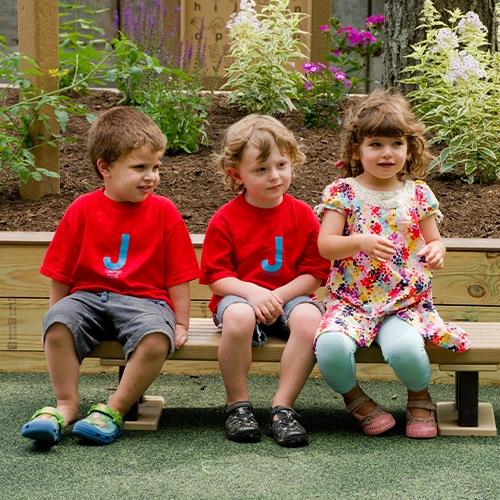
Outdoor Classroom Ideas
Children thrive when they learn through play. Outdoor environments offer endless possibilities for creative and imaginative play. Before you start designing your outdoor classroom, it’s crucial to consider the following questions:
- What is the age range of the children you are teaching?
- What are their hobbies and skills?
- What types of activities would you like to incorporate?
- What are the dimensions and layout of your outdoor area?
- What equipment and materials will be necessary?
- How will you ensure the safety and accessibility of the area for all children?
- What are the educational goals for your outdoor classroom?
Creating an inspiring outdoor classroom involves incorporating creative ideas that utilize the natural environment to enhance learning. Here are some engaging concepts to consider when designing your outdoor classroom:

Forest School
A forest school utilizes wooded areas to create a rich, immersive learning environment. Children can explore nature trails, observe wildlife, and participate in activities like building shelters or identifying plants and trees. This type of setting encourages exploration and fosters a deep connection with nature.
Beach School
A beach school takes advantage of coastal environments to offer a unique educational experience. Children can learn about marine life, coastal ecosystems, and the physical properties of sand and water. Activities might include beachcombing, studying tide pools, or creating sand sculptures, all promoting hands-on learning and environmental awareness.
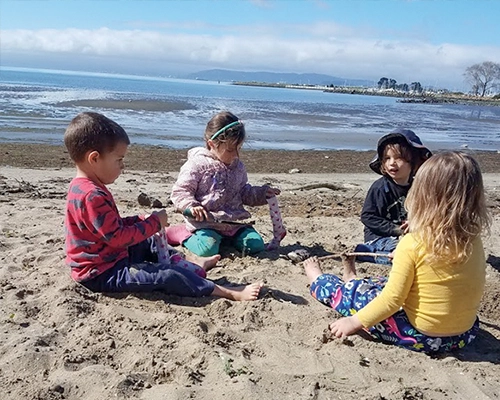
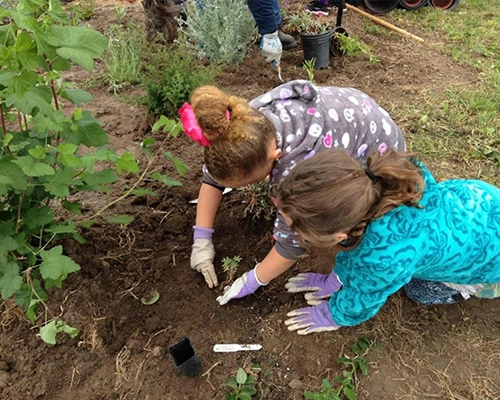
Farm-Based Classroom
A farm-based classroom allows children
to learn about agriculture and where their food comes from. Activities can include planting and harvesting crops, caring for animals, and understanding sustainable farming practices. This hands-on approach helps children appreciate the importance of farming and the food supply chain.
Mud Kitchen
A mud kitchen is a fantastic sensory play area where children can engage in imaginative play with mud, water, and natural materials. They can create “mud pies,” build structures, and experiment with different textures and consistencies. This type of play is fun and supports fine motor skill development and creativity.
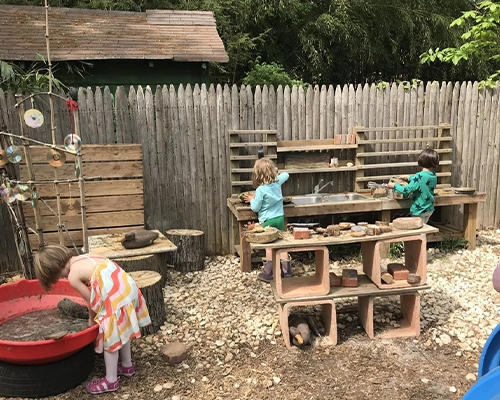
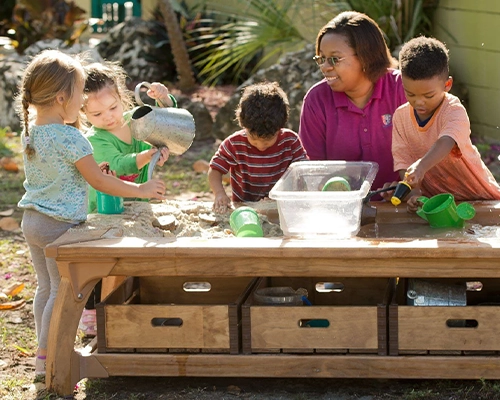
Water Play Area
A water play area can include elements like sprinklers, small pools, and water tables. Children can engage in activities that explore the properties of water, such as floating and sinking, measuring volume, and understanding water cycles. Water play is excellent for sensory development and encourages scientific inquiry.
Sandpit
A sandpit provides a dedicated area for children to dig, build, and explore. They can create sandcastles, dig tunnels, and engage in pretend play. Playing in the sand helps develop fine motor skills, hand-eye coordination, and creative thinking.
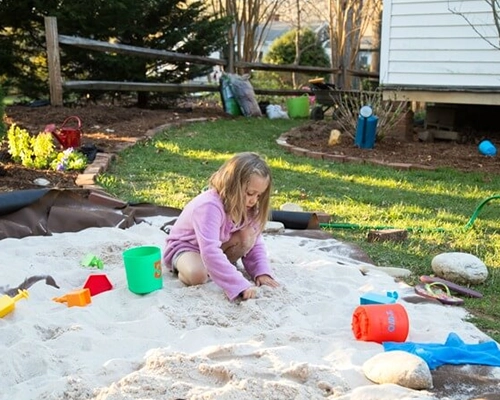
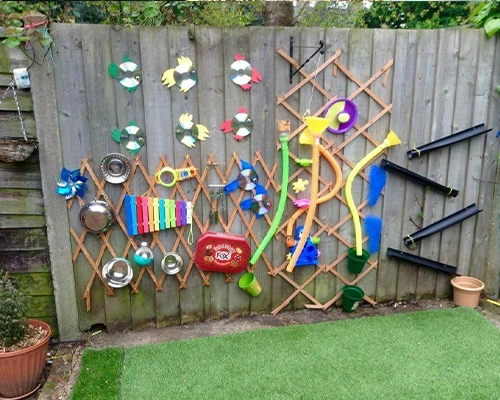
Sensory Garden
A sensory garden is designed to stimulate all five senses. It includes plants with various textures, colors, scents, and even edible elements. Features like wind chimes and water fountains add auditory stimulation. This type of garden helps children learn about the senses while providing a calming and therapeutic environment.
Music Garden
A music garden incorporates musical instruments made from natural materials, such as drums, xylophones, and wind chimes. Children can explore sound and rhythm, create music, and learn about the principles of music and acoustics. This space encourages creative expression and auditory learning.
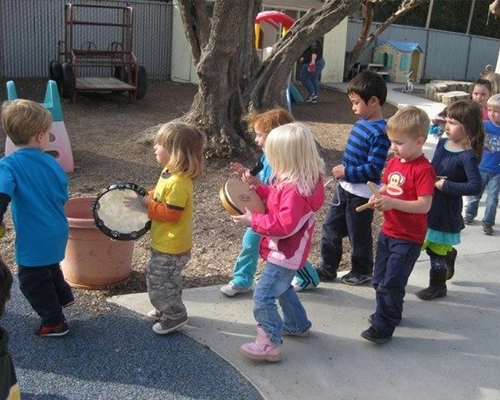
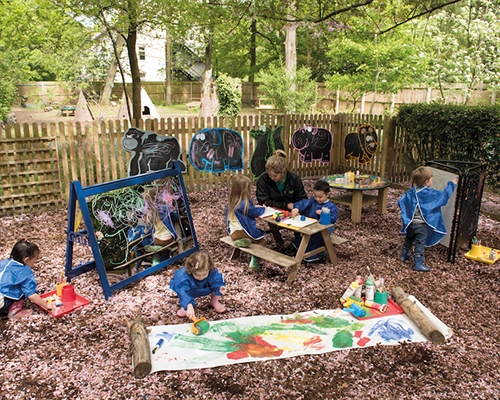
Outdoor Art Area
An outdoor art area provides space for children to engage in creative arts and crafts using natural materials. They can paint, draw, sculpt with clay, and create collages with leaves, sticks, and stones. This encourages artistic expression and allows children to connect with nature through artwork.
Loose Parts Area
A loose parts area is filled with objects like sticks, stones, pinecones, and shells that children can use to create and build. This open-ended play space encourages imagination, problem-solving, and critical thinking as children manipulate and combine materials innovatively.
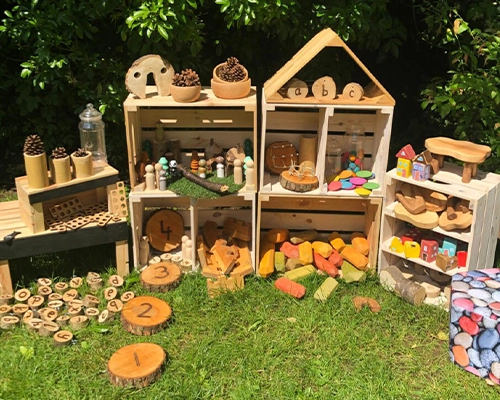
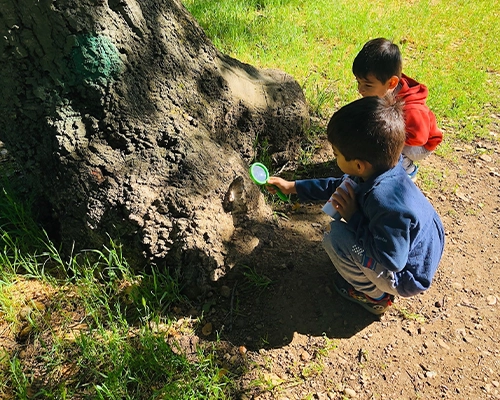
Nature Scavenger Hunt
A nature scavenger hunt involves giving children a list of natural items to find and collect. This can include leaves, flowers, rocks, and insects. Scavenger hunts encourage exploration, observation, and teamwork, making them a fun and educational outdoor activity.
Obstacle Course
An obstacle course can be set up with natural and man-made elements like logs, ropes, and tires. Children navigate through the course, including climbing, balancing, and crawling. This promotes physical fitness, coordination, and perseverance.
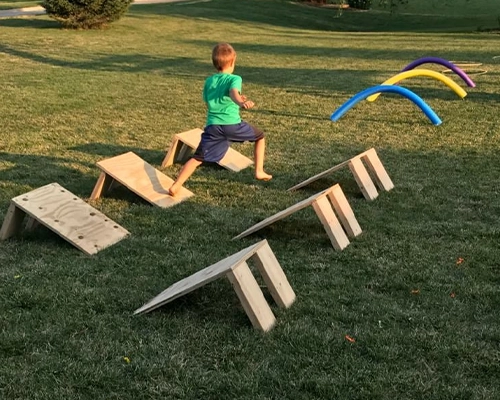
Outdoor Classroom Furniture
Choosing the right furniture for your outdoor classroom is essential to creating a comfortable and functional learning environment. Here are some critical pieces of furniture to consider:
Picnic Tables
Picnic tables provide a versatile space for group activities, meals, and crafts. They are sturdy and can withstand outdoor conditions. Children can gather around these tables for collaborative work and social interaction.
Chairs
Durable, weather-resistant chairs are essential for outdoor learning. They provide individual seating for children during lessons and activities. Look for chairs that are lightweight and easy to move so they can be arranged in different configurations.
Sofas
Outdoor sofas offer a comfortable seating option for reading, relaxing, or group discussions. Made from weather-resistant materials, these sofas can enhance the cozy feel of an outdoor classroom.
Tables
Additional tables of various sizes can be used for specific activities, such as science experiments, art projects, or snack time. Tables should be durable and easy to clean, accommodating different types of learning activities.
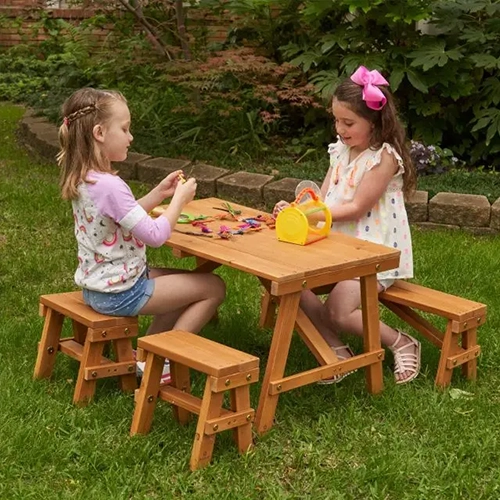
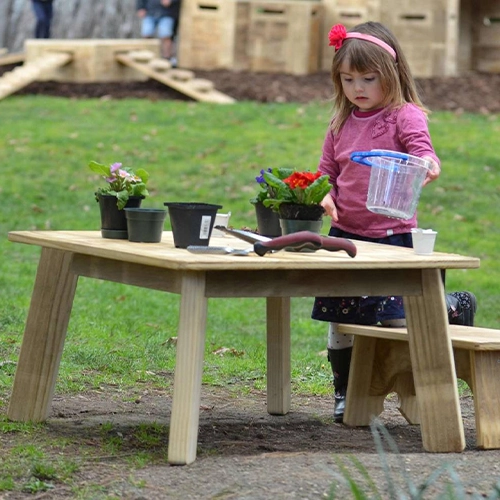
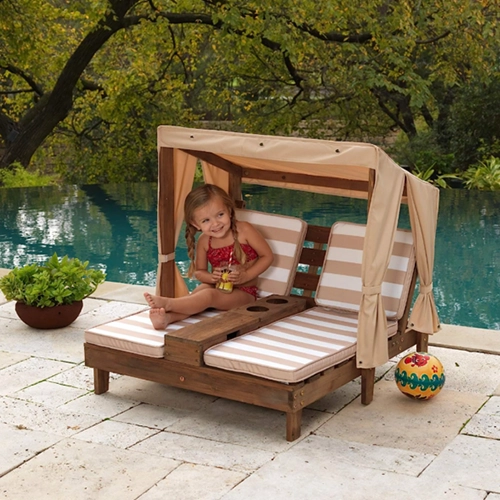
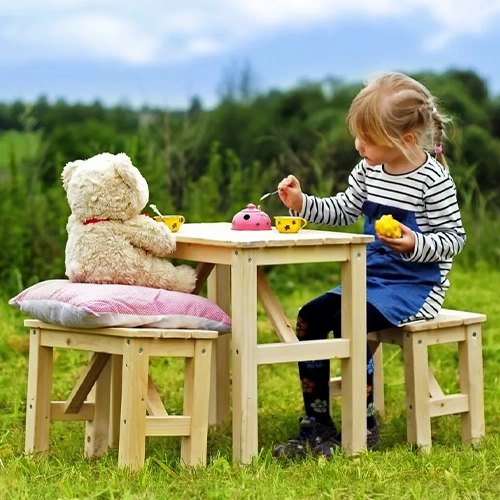
Benches
Benches provide flexible seating arrangements and can be placed around the learning area. They are great for group gatherings, storytelling sessions, and resting spots.
Storage Bins
Storage bins are crucial for keeping outdoor spaces organized. Use them to store tools, toys, art supplies, and learning materials. Weatherproof bins will protect contents from the elements.
Rugs
Outdoor rugs can define different areas within the classroom and provide a soft surface for sitting or lying down. Choose rugs made from materials that are easy to clean and resistant to weather conditions.
Canopies
Canopies provide shade and shelter, making it possible to use the outdoor classroom in various weather conditions. They protect children from the sun and rain, ensuring that learning can continue regardless of the weather.
Ottomans
Ottomans offer flexible seating options and can be used as small tables or footrests. They are portable and can be easily moved to create different seating arrangements.
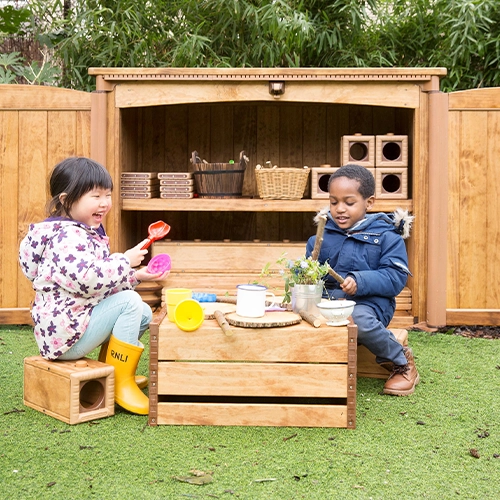

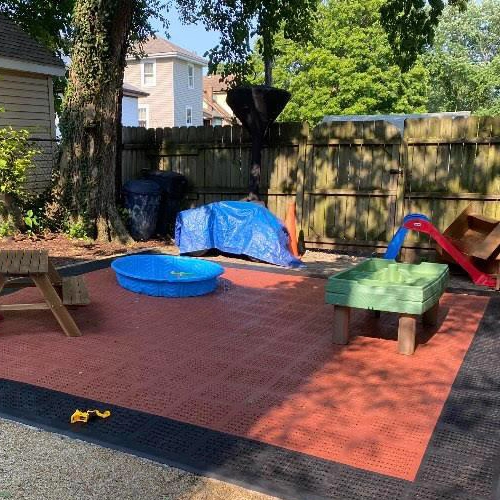
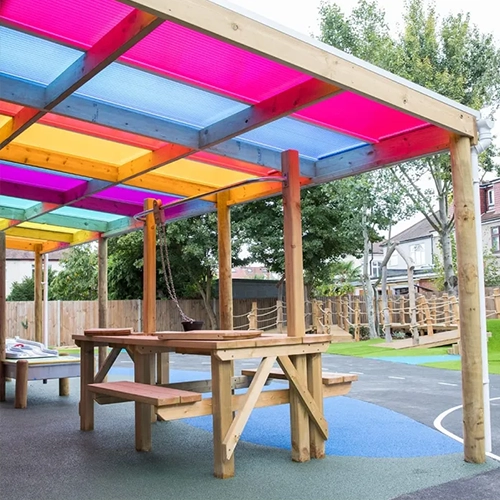
A well-planned outdoor classroom combines creative ideas with functional furniture to enrich the learning environment. By incorporating elements like forest schools, mud kitchens, and sensory gardens, and ensuring you have the right furniture like picnic tables and storage bins, you can create a space that fosters curiosity, engagement, and a love for learning in the great outdoors.
What Goes into a Great Outdoor Classroom?
Creating a great outdoor classroom requires careful planning and consideration of several vital factors. Ensuring these well-thought-out elements will help create a safe, engaging, and effective learning environment for children. Here are the primary aspects to consider:
1. Location
Choosing the right location is crucial for a successful outdoor classroom. The site should be easily accessible for both children and educators. It should be close enough to the primary school building for convenience but also provide a sense of separation from the indoor environment. Look for a space that is spacious, safe, and conducive to learning. Natural features such as trees, hills, and water sources can enhance the learning experience by providing diverse opportunities for exploration and observation.
Selecting an appropriate location also involves considering the environment. Is the area free from pollutants and hazards? Does it offer a variety of natural features that can be incorporated into the curriculum? A good location will inspire curiosity and a sense of adventure, encouraging children to engage more deeply with their surroundings.
2. Weather
Weather plays a significant role in the usability of an outdoor classroom. It’s essential to consider the local climate and how it will affect the use of the space throughout the year. For areas with variable weather conditions, creating sheltered spaces such as gazebos, tents, or covered patios can protect from rain or excessive sun, allowing activities to continue regardless of the weather.
Planning for different seasons is also essential. In warmer months, shade structures can keep children cool and comfortable. Ensuring warm, dry activity places in colder months can keep the outdoor classroom functional. Additionally, having proper drainage systems in place can prevent areas from becoming muddy and unusable after heavy rains.
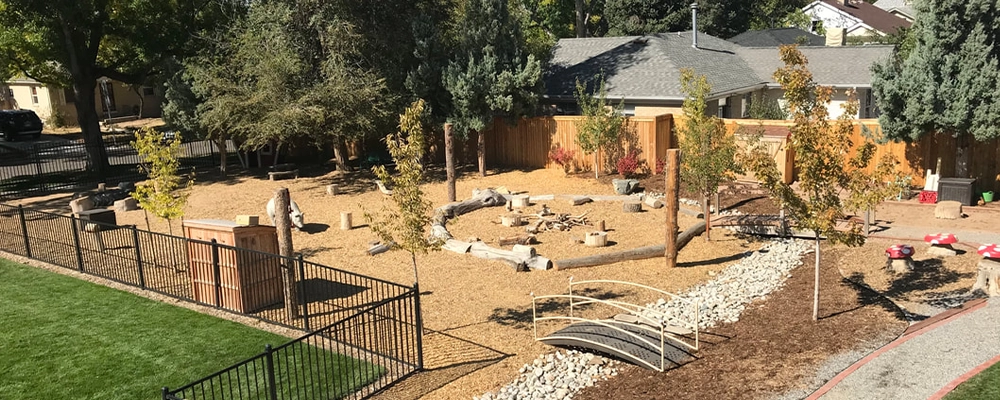
3. Safety
Safety is paramount in any learning environment; an outdoor classroom is no exception. Conduct a thorough risk assessment to identify hazards such as uneven ground, poisonous plants, or sharp objects. Implement measures to mitigate these risks, such as leveling the ground, removing harmful plants, and ensuring that all tools and equipment are safe for children.
Supervision is another critical aspect of safety. Ensure that the outdoor classroom is always within sight and easy reach of educators. Clear boundaries should be established to prevent children from wandering too far. Additionally, first aid kits should be readily available, and educators should be trained in basic first aid and emergency procedures.
Creating a safe outdoor classroom also involves teaching children about safety protocols. This includes understanding how to use tools properly, recognizing potential hazards, and knowing what to do in an emergency. Children can enjoy the outdoor classroom safely and confidently by instilling these practices.
4. Accessibility
Accessibility is essential to ensure that all children can participate in outdoor learning activities regardless of their abilities. The outdoor classroom should be designed to accommodate children with disabilities. This includes providing smooth, even paths for wheelchair access, ensuring that seating and workspaces are at appropriate heights, and including sensory-friendly areas for children with sensory processing needs.
Consideration should also be given to the ease of access to outdoor spaces. Ensure that the transition from indoor to outdoor areas is smooth and that no barriers could hinder movement. Accessible bathrooms and handwashing facilities should be nearby to promote hygiene and comfort.
Universal design principles can help create an inclusive environment that benefits all children. This means designing the space in a way everyone can use to the greatest extent possible without needing adaptation or specialized design. By prioritizing accessibility, the outdoor classroom becomes a welcoming and engaging space for every child.
In conclusion, a great outdoor classroom results from carefully planning and considering several key factors. By selecting the right location, preparing for various weather conditions, ensuring safety, and making the space accessible to all children, you can create an outdoor learning environment that is engaging, inclusive, and effective. With these elements, children can thrive in their outdoor classroom, enjoying the benefits of hands-on, experiential learning in a natural setting.
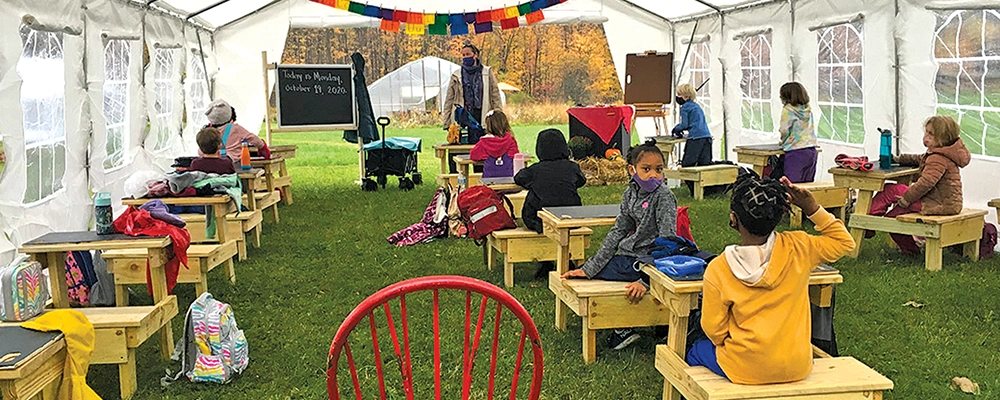
Creating an inspiring outdoor classroom is a rewarding endeavor that can significantly enhance children’s learning experiences. By carefully considering location, weather, safety, and accessibility, you can design a space that is not only functional but also engaging and inclusive. An outdoor classroom provides children with the opportunity to explore, discover, and connect with nature in a meaningful way. It fosters creativity, promotes physical activity, and supports holistic development. As educators and caregivers, it’s our responsibility to create environments that encourage curiosity and a love for learning. With thoughtful planning and dedication, your outdoor classroom can become a vibrant, dynamic learning space that benefits children for years.

